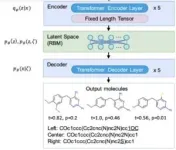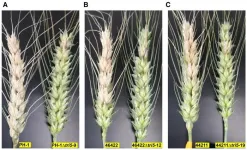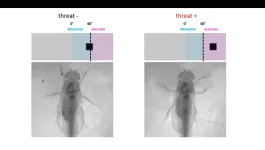(Press-News.org) Gero, an AI-driven biotech focused on aging and longevity, has demonstrated the feasibility of applying quantum computing for drug design and generative chemistry, which now offers significant promise for the future of healthcare. The research, published in Scientific Reports, outlines how a hybrid quantum-classical machine-learning model was used to interface between classical and quantum computational devices with the goal of generating novel chemical structures for potential drugs — an industry first.
The research paper follows in the wake of recent advancements from Gero, which sparked vigorous discussion among longevity experts in the scientific community when a story was published in Popular Mechanics that asserted Humans Can Stop—But Not Fully Reverse—Aging. Earlier this year, Gero announced a target discovery deal with Pfizer, whereby Gero’s machine-learning technology platform is being applied to discover potential therapeutic targets for fibrotic diseases using large-scale human data.
In this new line of research, the team explored whether a hybrid generative AI system — a deep neural network working in conjunction with commercially available quantum hardware — could suggest unique chemical structures that are synthetically feasible and possess drug-like properties.
The need for new computational approaches
The vast structural space of all possible drug-like molecules presents a monumental challenge in drug discovery. The number of realistic drug-like molecules is estimated to be between 10^23 and 10^60 — and only about 10^8 substances have ever been synthesized. This untapped molecular landscape could hold the keys to future game-changing treatments for currently incurable age-related diseases and aging itself. However, the size and complexity of this uncharted chemical diversity space requires innovative tools for the selection of novel, biologically active and, at the same time, synthetically accessible molecules waiting to be turned into future drugs.
“These breakthroughs pave the way for a dramatic acceleration of the drug discovery process," said Peter Fedichev, CEO of Gero. “Drug design operates at the intersection of the realms of classical and quantum phenomena, and requires simultaneous determination of quantum properties of drug-like molecules and their effects on living systems described by classical physics. This is why quantum computing will significantly augment our capacity to develop transformative treatments for the most challenging diseases and conditions, including aging itself.”
A team of researchers with wide-ranging expertise
The research team comprises leading experts in diverse fields, encompassing physics, modern machine learning, generative models, quantum physics, and drug design. As documented in the paper, Hybrid quantum-classical machine learning for generative chemistry and drug design, the researchers developed a hybrid model that combines a compact discrete variational autoencoder (DVAE, a generative chemistry algorithm) in a form that can run on an existing state-of-the-art quantum device called a D-Wave quantum annealer.
The proposed system is a hybrid quantum/classical generative mode trained to sample from the distribution of drug-like and synthetically available molecules. Once the training was complete, the system could be run in the generative mode and suggested 2,331 novel chemical structures with properties typical for biologically active compounds. Encouragingly, less than 1% of the generated molecules had a high similarity to any molecule in the training set, indicating a high level of novelty in the generated compounds.
Realizing the potential of quantum computing in drug discovery
The development of quantum algorithms and hybrid quantum-classical machine-learning models for drug discovery could significantly advance the field of medicinal chemistry. Because the vastness of the structural space of possible drug-like molecules poses a significant challenge for classical computing, quantum computing may offer a much more efficient approach. Molecules are archetypical quantum objects and hence quantum computers are naturally suited for solving complex quantum chemistry problems. And, based on the results from the scientific study, the team is now convinced that quantum algorithms can enhance machine learning in drug design—and could potentially evolve into ultimate generative chemistry algorithms.
As quantum hardware matures, specific components of the network could be converted into their fully quantum counterpart, potentially transforming the system into a Quantum VAE (QVAE) that could sample from richer, non-classical distributions. This could ultimately speed up the training of the system, potentially making quantum-enhanced generative models more efficient for drug-design applications.
“In this study, using a quantum computer, we explored an entirely new dimension in chemical space and opened a door to an entirely new room,” said Alexey Fedorov, head of the RQC research team that co-authored the paper with Gero. “As quantum computers become even more powerful, we expect that they will become more and more helpful in various studies, especially in the machine-learning domain applied to naturally quantum mechanical problems. In the next five to ten years, we will see a new generation of drugs and materials created with the help of quantum computers.”
As documented in Scientific Reports, the research established two important conclusions:
1. Hybrid quantum-classical machine learning has excellent potential for drug-discovery applications. The researchers demonstrated that it is feasible to use hybrid architectures that combine quantum computers with deep classical networks for drug-discovery applications. They built a compact and yet sufficiently powerful model, small enough to fit on a state-of-the-art D-Wave quantum annealer and trained this model on a subset of the ChEMBL dataset of biologically active compounds.
2. We can generate novel chemical structures using a commercially available quantum machine. The hybrid quantum-classical model generated 2,331 novel chemical structures with medicinal chemistry and synthetic accessibility properties in the ranges typical for biologically active molecules from the ChEMBL dataset. Importantly, the quantum computer used to perform the calculations is available as cloud computing infrastructure.
What this means for drug discovery
Further develop quantum machine-learning models. The scientific report demonstrated that a hybrid quantum-classical machine learning model can generate novel drug-like molecules. The next step is to further develop and refine these models. This includes enhancing the generative capabilities of the model to generate more diverse and novel molecules and optimizing the efficiency of the models.
Transition to full quantum models. The researchers used a hybrid quantum-classical model as a stepping stone towards fully quantum generative models. As quantum hardware matures, the Restricted Boltzmann Machine (RBM) used in the study could be transformed into a Quantum Boltzmann Machine (QBM), and the whole system might be transformed into a Quantum Variational Autoencoder (QVAE) that could sample from potentially richer non-classical distributions.
Incorporate additional properties. For actual drug design, the models should be able to predict additional properties, such as the binding constant to a specific target, on top of generating novel compounds. This would allow for the generation of compounds designed to bind specific medically relevant targets.
Collaborations and partnerships. Quantum computing and drug discovery are complex fields that require expertise from many different areas. Collaborations between quantum computing experts, pharmaceutical companies, and medical researchers would be beneficial in moving the field forward.
Fedichev sees enormous promise for the application of quantum computing to address lifespan and healthspan:
“Our goal is to slow down or even stop human aging. This is no small feat and will require intense effort and the fusion of probably yet unknown amounts of technology borrowing from the science of complex systems, modern AI and machine-learning technologies, vast biomedical datasets, and revolutionary bioengineering,” he added. “Recognizing the potential of quantum computing and quantum machine learning — a rapidly advancing field with immense promise — we have incorporated these into our arsenal, setting the stage for much-needed advancements in drug design against aging.”
Gero invites partnerships for novel target identification and comprehensive drug discovery collaborations, as exemplified by its recent work with Pfizer. Gero’s scientific excellence and outstanding drug-discovery capabilities are the basis for the range of landmark papers in aging and drug discovery fields that shape the future of the industry, published in numerous magazines, including Nature Communications (1, 2, 3, 4), Science journals and is covered by Scientific American, Popular Mechanics (5, 6), and other media outlets.
About Gero
Gero is a biotechnology company using physics-based generative models on massive human health record datasets, combined with AI-guided drug design, to develop meaningful interventions for aging and age-related diseases. To achieve that goal, Gero acquired a massive dataset of longitudinal, real-world medical records and built a generative, very large model of human health. The model is based on principles adopted from the physics of complex and dynamic systems and reveals the irreversible nature of human aging while highlighting the reversible aspects of diseases, distinguishing the two phenomena. It also reveals causal relationships between microscopic molecular- and organism-level features associated with diseases to enable rapid targeting and drug discovery, directly in human data. To learn more about how Gero is hacking complex diseases and aging, visit gero.ai.
Media contact:
Tim Cox | ZingPR for Gero
tim@zingpr.com
END
Longevity biotech startup Gero demonstrates the power of quantum computing in drug design
New research demonstrates commercially available quantum computing services can accelerate discovery of a new universe of unique chemical structures that are synthetically feasible and possess drug-like properties to address complex diseases and aging
2023-07-13
ELSE PRESS RELEASES FROM THIS DATE:
Timing of turkey nesting may not shift with changing climate
2023-07-13
A new study suggests eastern wild turkeys in five southern U.S. states are unlikely to make meaningful changes in the timing of when they begin nesting, even under significant future climate change.
The findings suggest eastern wild turkeys (Meleagris gallopavo silvestris) could be vulnerable to shifts in climate, which could threaten the availability of their food sources, the amount of vegetation cover available to protect them from predators, and other factors.
“There are implications here for turkey populations ...
New toxin facilitates disease infection and spread in wheat
2023-07-13
Although wheat was among the first domesticated food crops, it remains a global dietary staple several millennia later. Grown on every continent except Antarctica, wheat is the second highest produced grain worldwide, with nearly 800,000 metric tons grown each year (Food and Agriculture Organization). However, a fungal pathogen named Fusarium graminearum causes the devastating disease Fusarium head blight (FHB) on wheat and contaminates grains with harmful toxins called trichothecenes. One such trichothecene, called deoxynivalenol (DON), is produced by most F. graminearum strains in the United States, and it is an essential virulence factor that increases the pathogen’s spread ...
FAU receives $11.5 million gift to combat life-threating illness, amyloidosis
2023-07-13
Currently, there is no cure for amyloidosis, a life-threatening disease that can be present throughout the body, including the heart, kidneys, liver and brain. The most common localized form of amyloidosis, which is seen significantly more often, is in the brain. Cerebral amyloidosis, when symptomatic, usually manifests in one of two ways: in Alzheimer’s disease and related dementias and in brain bleeds, which have consequences such as a stroke.
Because amyloidosis does not affect a specific organ, unraveling the underlying cause of amyloid fibril creation – a hallmark ...
Schmidt Marine Technology Partners announces recipients of $3.5 million global sustainable fisheries initiative
2023-07-13
SAN FRANCISCO—Schmidt Marine Technology Partners, a program of the Schmidt Family Foundation, has awarded $3.5 million in grants to ten organizations and universities in seven countries for the development of new tools and innovations that will improve the sustainability of global fisheries, the program announced today.
“Tens of millions of jobs around the world depend on fisheries, and seafood is the primary protein source for 3 billion people,” said Wendy Schmidt, president and co-founder of the Schmidt Family Foundation. “The innovators chosen to receive these grants are ensuring that fishers and ...
New material could hold key to reducing energy consumption in computers and electronics
2023-07-13
A University of Minnesota Twin Cities team has, for the first time, synthesized a thin film of a unique topological semimetal material that has the potential to generate more computing power and memory storage while using significantly less energy. The researchers were also able to closely study the material, leading to some important findings about the physics behind its unique properties.
The study is published in Nature Communications, a peer-reviewed scientific journal that covers the natural sciences and engineering.
As evidenced by the United States’ recent CHIPS and Science Act, there is a growing need to increase semiconductor manufacturing ...
Artificially grown ‘mini-brains’ without animal components bring opportunities for neuroscience
2023-07-13
Researchers at University of Michigan developed a method to produce artificially grown miniature brains — called human brain organoids — free of animal cells that could greatly improve the way neurodegenerative conditions are studied and, eventually, treated.
Over the last decade of researching neurologic diseases, scientists have explored the use of human brain organoids as an alternative to mouse models. These self-assembled, 3D tissues derived from embryonic or pluripotent stem cells ...
Fear is in the eye of the beholder
2023-07-13
Averting our eyes from things that scare us may be due to a specific cluster of neurons in a visual region of the brain, according to new research at the University of Tokyo. Researchers found that in fruit fly brains, these neurons release a chemical called tachykinin which appears to control the fly’s movement to avoid facing a potential threat. Fruit fly brains can offer a useful analogy for larger mammals, so this research may help us better understand our own human reactions to scary situations and phobias. Next, the team want to find out how these ...
Multiple ecosystems in hot water after marine heatwave surges across the Pacific
2023-07-13
(Santa Barbara, Calif.) – Rising ocean temperatures are sweeping the seas, breaking records and creating problematic conditions for marine life. Unlike heatwaves on land, periods of abrupt ocean warming can surge for months or years. Around the world these ‘marine heatwaves’ have led to mass species mortality and displacement events, economic declines and habitat loss. New research reveals that even areas of the ocean protected from fishing are still vulnerable to these extreme events fueled by climate change.
A study published today in Global Change Biology, led by researchers at UC Santa ...
When the stars align: Astronomers find answers to mysterious action of ghost stars in our Galaxy
2023-07-13
A collaboration of scientists from The University of Manchester and the University of Hong Kong have found a source for the mysterious alignment of stars near the Galactic Centre.
The alignment of planetary nebulae was discovered ten years ago by a Manchester PhD student, Bryan Rees, but has remained unexplained.
New data obtained with the European Southern Observatory Very Large Telescope in Chile and the Hubble Space Telescope, published in Astrophysical Journal Letters, has confirmed the alignment but also found a particular ...
Skin lightening products can be dangerous, but users don’t know risks
2023-07-13
· Colorism – system of inequality that views lighter skin as more beautiful and advantageous – motivates skin lightening
· Users aren’t aware of adulterated ingredients in over-the-counter products such as mercury and steroids
· Products are purchased from chain grocery stores or online, used without medical advice
CHICAGO --- Skin lightening is prevalent in the U.S. among skin of color individuals – particularly women – but the people who use those products don’t know the risks, reports a new Northwestern ...
LAST 30 PRESS RELEASES:
Air pollution exposure and birth weight
Obstructive sleep apnea risk and mental health conditions among older adults
How talking slows eye movements behind the wheel
The Ceramic Society of Japan’s Oxoate Ceramics Research Association launches new international book project
Heart-brain connection: international study reveals the role of the vagus nerve in keeping the heart young
Researchers identify Rb1 as a predictive biomarker for a new therapeutic strategy in some breast cancers
Survey reveals ethical gaps slowing AI adoption in pediatric surgery
Stimulant ADHD medications work differently than thought
AI overestimates how smart people are, according to HSE economists
HSE researchers create genome-wide map of quadruplexes
Scientists boost cell "powerhouses" to burn more calories
Automatic label checking: The missing step in making reliable medical AI
Low daily alcohol intake linked to 50% heightened mouth cancer risk in India
American Meteorological Society announces Rick Spinrad as 2026 President-Elect
Biomass-based carbon capture spotlighted in newly released global climate webinar recording
Illuminating invisible nano pollutants: advanced bioimaging tracks the full journey of emerging nanoscale contaminants in living systems
How does age affect recovery from spinal cord injury?
Novel AI tool offers prognosis for patients with head and neck cancer
Fathers’ microplastic exposure tied to their children’s metabolic problems
Research validates laboratory model for studying high-grade serous ovarian cancer
SIR 2026 delivers transformative breakthroughs in minimally invasive medicine to improve patient care
Stem Cell Reports most downloaded papers of 2025 highlight the breadth and impact of stem cell research
Oxford-led study estimates NHS spends around 3% of its primary and secondary care budget on the health impacts of heat and cold in England
A researcher’s long quest leads to a smart composite breakthrough
Urban wild bees act as “microbial sensors” of city health.
New study finds where you live affects recovery after a hip fracture
Forecasting the impact of fully automated vehicle adoption on US road traffic injuries
Alcohol-related hospitalizations from 2016 to 2022
Semaglutide and hospitalizations in patients with obesity and established cardiovascular disease
Researchers ‘listen in’ to embryo-mother interactions during implantation using a culture system replicating the womb lining
[Press-News.org] Longevity biotech startup Gero demonstrates the power of quantum computing in drug designNew research demonstrates commercially available quantum computing services can accelerate discovery of a new universe of unique chemical structures that are synthetically feasible and possess drug-like properties to address complex diseases and aging







